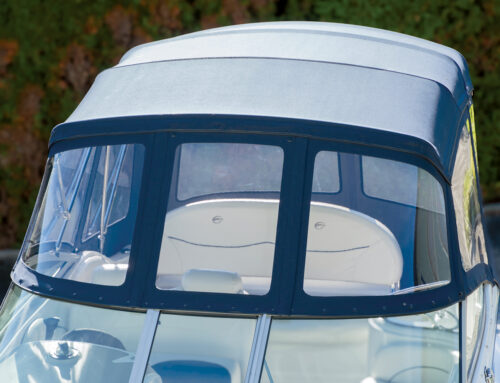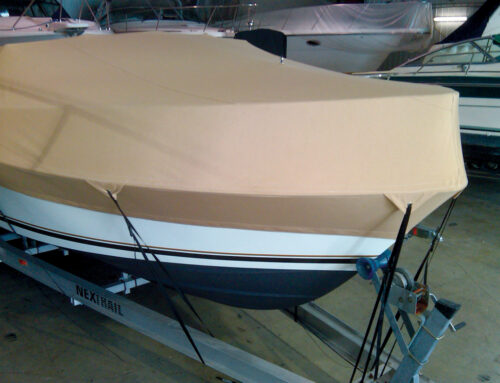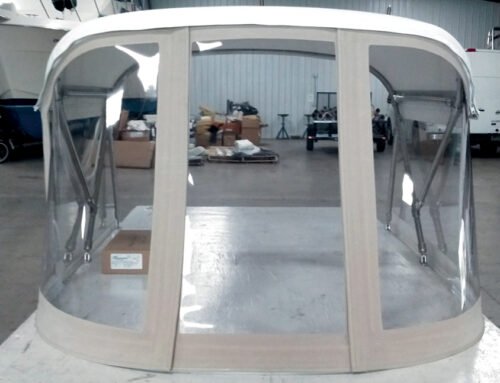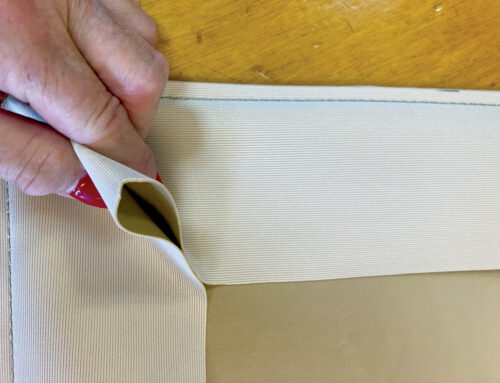Covering canvas repairs
Editor’s note: Don Racine, a longtime Marine Fabricators Association member and supporter, died on April 18 as the result of a heart attack. He was 61. View Don Racine’s full obituary.
This article is about canvas repairs: We will discuss bimini tops, cockpit covers and full-boat travel covers.
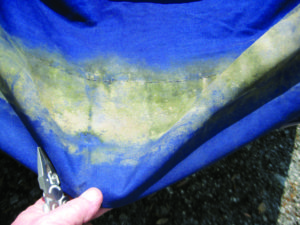
1) Torn and dirty canvas is no stranger to marine fabricators. Sand, dirt and mold all have to be removed before running the fabric through a sewing machine.
When we look at some of the canvas that comes into our shop, it appears to have been stored in a garage and is full of sand and dirt (photo 1), leaves and even a mouse or two!
The first task on the agenda is cleaning the product, as we will have to put the canvas under our sewing machine, and we all know dirt and sand is a real problem for our machines. We must tell the customer that the product needs to be cleaned and treated, too. This will drive up the cost, and if the customer decides to clean it him or herself, it is one less process you have to tackle. Some shops offer a care-and-cleaning service; others prefer not to, and that’s OK. Over the past few years, we have offered a care-and-cleaning class in our shop in the evening after work hours. We present the class every six weeks or so, and customers really love it. They even bring other boating buddies along. Have a signup sheet at your shop and see how many are interested. You might be surprised!
Some covers are beyond repair. Those are usually the cheap ones customers purchased the previous year and let it fill up the boat with leaves; the seams might be torn so badly that we would have to use more material than it was made with. Those are the ones we say are beyond repair.
Sell your customer a new cover and tell them you are going to create one that will exactly fit their boat and that you will reinforce all stress areas and around the windshield and cleats etc. Add a manufacture warranty—three or five or 10 years—to the sale. You are offering the manufacturer’s warranty to your project. Get a label from the manufacture (they are free) and sew it into the project next to your name. If you are using a better grade thread, sew that maker’s tag in, too. The tags justify the price and give the customer the idea you are a professional in your field. Some threads have a lifetime warranty, and your customers will be happy to know they will not have the same problem again.
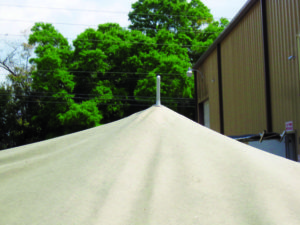
2) Allowing the point of a support pole to extend beyond the fabric allows easier access to resetting the pole upright in the event it should fall over. The large grommet hole allows rainwater to escape.
We also use a support pole (2) with a #4 grommet in it so the pole will slide inside and stick out approximately 3 inches above the cover. There are two reasons for this: If the cover support pole falls down you can reach outside the cover and grab the 3-inch extension to stand it back up, rather than having to remove the cover and crawl inside to stand it up. And, I like the grommet system because if a big storm occurs while no one is onsite, the pole might fall down but the water will drain through the #4 grommet and out through the boat’s drain. I have seen covers pull down windshield and bend railings. One cover had so much water in it that it broke the trailer. Remember, water weighs about seven pounds a gallon, so it does not take much to do some damage.
In the South, we have to use “breathable” products. Urethane-coated material in the South will sweat and condense water under the sealed cover and cause major damage. Mold and mildew can destroy a boat in just a few months, especially in the summer. Vents must be installed to prevent this. The cover must also be removed regularly for the boat to dry out.
In cooler northern climes, urethane-coated products are great; they allow snow-cover and water-proof sealing in that climate. Because humidity is lower at lower temperatures, you do not have to deal with the same problems as the southerners do. In the Midwest, I have seen both products used; fabricators just have to remember the ventilation. We use a solution-dyed breathable acrylic for this purpose, or a polyester fabric with vents installed.
I have used a fabric (screen) for ventilation with a curved cover (3, 4 and 5), in vertical areas on the cover to ensure good ventilation. I like to have three or four vents to allow enough air to circulate under the cover, and even more on a bigger vessel.
-

- 3) A series of fabric mesh screens provides good ventilation. The curved cover (right) helps keep out rain.
-
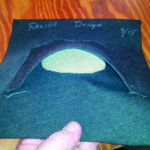
- 4) A series of fabric mesh screens provides good ventilation. The curved cover (right) helps keep out rain.
-
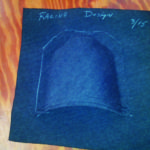
- 5) A series of fabric mesh screens provides good ventilation. The curved cover (right) helps keep out rain.
On to repairs. I have found a number of shortcuts while doing repairs.
With the cover now cleaned and laid out over the table, if there are tears I have found that I can simply cut another piece of fabric larger than the hole and lay it on top and trace around it, then I flip the patch over and spray it with a webbing adhesive spray and lay it back on the hole. Allowing a few minutes for the adhesive to dry, I can go to the next hole or tear and lay a piece over that. As you move along, lay each patch under your machine and sew around the perimeter. Once that is finished, flip it over and sew the edge where the tear is. This makes the repair quick and simple.
When the straps have been pulled out, look for the initial cause. Reinforce an area above the pull about five inches wide and make it into a V shape. Let the bottom of the V protrude past the edge, and add a grommet or a webbing tab and add the new tie-down rope. You can make as many of these as you need to replace; usually I make all new ones as the reinforcement you are putting in will be stronger that the original and the ones you don’t replace now will be the first failure spots if you leave the original. Perimeter ropes are more difficult, and I have seen many with the rope rotting off at the exposed end. I try to add a new rope by cutting the original seam back and then tying or using a hog ring to pull an entire new rope in place. I always leave extra rope and let the customer decide how long he wants the tails.
Reinforce over those areas where the stress is; for example, trolling-motor blades that are very sharp can shred a fabric. I use plastic PVC sheeting in .024 thickness; you could use a piece of clear 40 or even 60 gauge clear vinyl (window material). I have also used some of the new polycarbonate materials, too. We usually save all small pieces after a job and put them in a box as repair scraps. You won’t need to get a full sheet out just for that purpose.
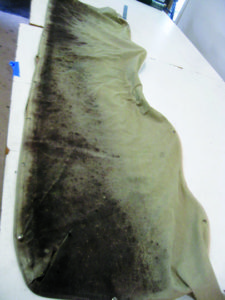
6) There seems to be no limit to the grit and grime some boaters allow to accumulate on their canvas. A replacement is often less expensive than a repair.
Fixing the old covers can make a customer happy, though I sometimes find the repair cost more than a new one (6).
After cleaning the canvas, treat it with an approved product and give the customer a small bottle to take with them.
Explain the instructions or go over it with them at your shop—remember: “Real men” do not read instructions, and he will sound so smart around his buddies. Also, show your customer what the manufacture recommends for care and cleaning; those products are available online from each manufacture. They usually will respond with thanks, and they also have your email address in case they decide to get another cover made.
Once the cover has been repaired, fold it so the access to the repairs can be seen, explain the repairs, and let your customer know of any other areas that could be a problem in the future. I put a note in each customer’s file and have it available when the repair is due again. It is a small thing, but you know where the previous repairs were done.
Canvas repairs are touchy. I tell my customers when the fabric is not worth repairing or that it would not be worth what I have to charge them.
Repairs can be profitable, but some offer headaches, too. I usually test an area near the damage and see if it can be torn easily. If not, the repair could be worth your time.
Don Racine owns Racine Design Inc. in Jacksonville, Fla. www.Boatclinic.net
 TEXTILES.ORG
TEXTILES.ORG 


